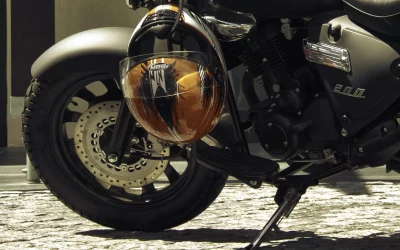Motorcycle vs Car Accidents: What’s the Difference?
Motorcycle accidents are unique when compared to other types of car accidents. Although there are some parallels between motorcycle and car accidents, motorcycle accidents are distinct due to the dangers of riding a motorcycle, the causes of accidents, the injuries incurred, and liability difficulties.
Motorcycles have just two wheels, no seatbelts or airbags, and are, by definition, significantly smaller than conventional cars. Motorcycles also lack the safety of being contained and protected by metal.
Motorcyclists confront various problems that car drivers do not, including restricted sight, road hazards such as trash, pebbles, and mud, and poorer stability. Motorcycle accidents are harder to manage than car accidents since they typically end in harm.
Motorcyclists often suffer more severe and permanent injuries as a result of their vulnerability on the road. Motorcyclists may require additional long-term financial support to pay for medical care after a permanent spinal cord or brain injury. Motorcycle accident victims may face additional challenges in court from jurors who view bikers as
Free Consultation
In Person | Phone | Zoom
Statistics on Motorcycle and Car Accidents
Studies and statistics have confirmed motorcycle accidents:
Motorcycle riders over the age of 40 are approximately 20 times more likely to be injured in an accident than car drivers of the same age. Motorcycle riders under the age of 40 are approximately 36 times more likely to be fatally injured in an accident than drivers of the same age.
Motorcycle riders under the age of 40 are approximately 36 times more likely to be killed in an accident than drivers of the same age. Motorcycle accidents result in injury or death 8% of the time, but car accidents only end in injury or death 20% of the time.
Motorcycles account for only 2% of all registered cars, yet they account for about 5% of roadway deaths.
Statistics on Car Accidents
Although data and research on car accidents vary from those on motorcycle accidents, there are still a significant number of wounded and fatally injured accident victims:
According to the US Department of Transportation, the typical motorist will get in a car accident every six years, and drivers will have a near call at least once or twice a month.
In 2005, 39,189 people died in car accidents, with 27,472 drivers and 10,036 passengers killed.
The National Safety Council estimates over 12 million motor car accidents occur each year, involving over 20 million cars.
Car accidents cause approximately 2 million debilitating injuries each year, according to statistics. According to studies, up to 75% of car accident injury victims have symptoms up to 6 months following the event.
According to research conducted by the National Highway Traffic Administration, roughly 28% of people in motor car accidents incur mild to moderate injuries, while about 6% sustain severe or fatal injuries.
Motorcycle Accident Prevention Advice
Every day, car and motorcycle accidents occur; although this is unlikely to change, certain steps may be taken to prevent injuries and deaths in motorcycle and car accidents. Because motorcycles are smaller than other cars on the road, they are sometimes overlooked until too late to prevent a collision.
Riders should always wear a helmet and should wear bright colors or leathers for safety. Riders should consider using safety goggles if their helmet does not have a face shield. Motorcyclists should also avoid riding at night as much as possible since other cars will have a harder time seeing them, increasing the chance of an accident.
Wear a Helmet: One of the most important safety precautions is to wear a helmet. Wear a well- fitting helmet. While it won’t protect you from damage, it will keep your head safe; head injuries are the primary cause of mortality among motorcycle riders.
Wear the Right Clothing: Leather and other specialized or armored motorcycle gear may prevent you from slipping on asphalt or other road dangers (such as small rocks, like small rocks, and cigarette butts). Motorcycle boots are also a smart idea to protect your feet from the heat of the engine and the tarmac in the case of a accident. The use of bright colors or reflective material might help you stand out from other drivers on the road.
Driving Within Your Skill Level: Always drive within your skill level; if you are not competent, do not
try to go at fast speeds or weave in and out of traffic.
Allow Enough Room: While motorcycles take up less area to stop and maneuver than cars, they nonetheless need more space than you may imagine. Practice stopping in a safe area on your bike, so you know how much room to give yourself in traffic and how much space to allow between you and the car in front of you.
Avoid Distraction: Distracted driving is terrible in general, but it’s much worse when you’re riding a bike. When you’re fumbling with your phone or iPod, your response time is slowed, placing you at a larger chance of colliding with anything.
Look Twice: Never assume the driver sees you; ride defensively and take responsibility for keeping yourself safe near cars.
Keep an eye on the weather: Motorcycles are less stable than cars, and travelling in the rain on a bike is significantly dangerous; two wheels provide half the traction of a car. Furthermore, your sight is harmed without windshield wipers.
Accident Injuries in Cars and Motorcycles
While car accident injuries vary in severity, there are a few frequent ones. Some are small and recover in a matter of days, while others are persistent and may lead to disability. Lacerations, shattered bones, spine, back, and neck damage, internal injuries, and concussion or traumatic brain injury are all possible in car accidents.
It’s crucial to note that, unlike motorcyclists, car accident victims have the extra protection of a car’s enclosure, airbags, and seatbelts. Motorcyclists are also 26 times more likely than passenger car passengers to die in an accident and five times more likely to be wounded.
Motorcycle accidents often result in injuries comparable to those sustained in car accidents, while a few ailments are specific to motorcycle accidents. Motorcycle accidents, for example, often result in road burn or road rash.
When motorcyclists have dragged down the tarmac at high speeds due to an accident, they suffer friction burns that rip away skin and tissue. Biker’s arm is a rare motorcycle injury in which a motorcyclist’s arm bones and tissue are severely damaged due to absorbing the force of a collision with another car.
Accidents and Their Causes
Both motorcycle and car accidents are often caused by speeding and/or intoxication. Between 2004 and 2013, speeding, drinking, and/or distracted driving were factors in 58 per cent of fatal traffic accidents, according to the Department of Transportation’s Fatality Analysis Reporting System (FARS). Alcohol was involved in 31% of fatal accidents, resulting in the deaths of almost 116,000 people. In 31% of fatal collisions, speeding was a contributing factor.
In 18 per cent of fatal accidents, distracted driving was a factor. Despite several focused media efforts warning against the hazards of driving while using a mobile phone, the Department of Transportation concluded that cell phone usage was a significant factor in under 1% of fatal accidents between 2004 and 2013. However, the number of non-fatal car accidents caused by cell phone usage is greater.
More information on the most prevalent causes of car and motorcycle accidents may be found here.







